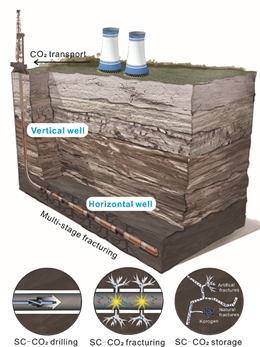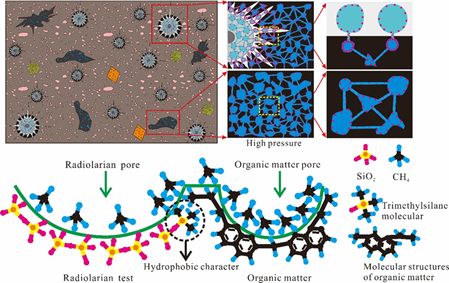An interdisciplinary team led by Professor Tan Jingqiang from the School of Geosciences and Info-physics of Central South University (CSU), has recently made important progress in the research on geological CO2 utilization and geological research of shale gas in conjunction with top teams in multiple professional fields from the United States, the United Kingdom, Australia and other countries, with the related achievements published in the journals such as Energy & Environmental Science, Chemical Engineering Journal, AAPG Bulletin, Palaeogeography Palaeoclimatology Palaeoecology and Marine and Petroleum Geology.
In the context of achieving "peak carbon dioxide emissions" and "carbon neutrality", it is important for China to accelerate the construction of a clean, low-carbon, safe and efficient energy system. China is abundant in shale gas which is an important strategic resource for the transition to low-carbon energy. At present, the shale gas is mainly recovered and utilized by the hydraulic fracturing technology, but this technology consumes plenty of water and may potentially cause environmental risks. Since 2017, Professor Tan has taken the R & D of new supercritical CO2 fracturing technology as one of the key goals of the team. Recently, the team was invited to publish a paper entitled "The role of supercritical carbon dioxide for recovery of shale gas and sequestration in gas shale reservoirs" in Energy & Environmental Science, a top journal in the field of international energy and environment.Based on the current status and deficiencies of shale gas recovery, the application prospects of supercritical CO2in the efficient recovery of shale gas is deeply studied in this paper, especially the advantages of supercritical CO2 in drilling and fracturing, as well as the feasibility of CO2storage in shale reservoirs in the fracturing process; the special attention is paid to the analysis of challenges faced by the efficient recovery of shale gas strengthened by supercritical CO2 and the CO2storage in shale reservoirs, including the diffusion and adsorption of CO2in shale gas reservoirs, the impact of CO2-shale or CO2-water-shale interaction on the properties of shale, as well as the cost, environmental impact and life cycle risk assessment of the application of supercritical CO2 in the recovery of shale gas; and the future development direction in this field is indicated. CSU is regarded as the organization of the first and corresponding author, Associate Professor Lu Qiao of the research group as the first author, and Professor Tan Jingqiang as the corresponding author. The co-authors of the paper come from the World-renowned universities, scientific research institutions and companies, such as the University of Chinese Academy of Sciences, Los Alamos National Laboratory (U.S.A), Carbon Solutions (U.S.A), Monash University (Australia), Heriot-Watt University (United Kingdom) and DWA (United Kingdom).

Fig.1 Application of Supercritical CO2in the Recovery of Shale Gas
The research on the pore structure of organic-rich shale has always been the core of the evaluation for shale oil and gas resources, and also a hot spot and frontier in the field of geology. With the high-precision and high-resolution ultrastructure analysis techniques, the team lead by Professor Tan Jingqiang conducted a multi-scale, omni-directional qualitative and quantitative characterization and multi-factor comprehensive analysis on the micro-nano pore structure of the organic-rich shales in the Lower Paleozoic in southern China, discovered the characteristics and differences of the biological pores of different types of microfossils, and quantitatively revealed the influence of microfossil pore structure represented by radiolarians on shale reservoirs for the first time, established the microscopic pore structure model of the symbiosis of radiolarians and organic matter, proposed a new pore classification method based on organic pores, mineral matrix pores and micro-paleontological pores, systematically explained the important influence of a large number of micro-nano biological pores retained in micro-fossils on shale gas enrichment, and proposed the new parameters for the prediction of shale sweet spots to lay the foundation for the micro-fossil-enriched interval as a mark bed for shale gas exploration and recovery. Relevant research achievements in this field were published in the famous journals in the field of chemical engineering and environment such as Chemical Engineering Journal (IF:10.652), and the well-known international journals in the field of oil and gas such as Marine and Petroleum Geology and Journal of Natural Gas Science and Engineering. CSU is regarded as the organization of the first and corresponding authors of related papers, Doctoral candidate Hu Ruining as the first author, and Professor Tan Jingqiang as the corresponding author.

Fig.2 Methane Adsorption Model and Adsorption Mechanism of Microfossil-rich Shale
In addition, with the trace element and isotope analysis techniques, the team led by Tan Jingqiang discovered the oldest mercury anomaly in the Lower Paleozoic strata for the first time in view of the complex characteristics of the sedimentary evolution and organic matter enrichment mechanism of the Early Paleozoic marine shale in southern China, systematically revealed the response relationship between volcanic/hydrothermal activities, sedimentary environment and biological evolution in South China, and proposed a new model of sedimentary evolution of the black shale at the bottom of the Cambrian in South China. Through in-depth study of the early Cambrian paleo-ocean climate, initial productivity, redox conditions, hydrothermal activity, terrestrial dilution and water retention in South China, the team have systematically revealed the source and preservation conditions of marine shale organic matter, and furtherly studied and discovered the interrelationship among hydrothermal activity, ocean initial productivity, and sedimentary environment and its influence mechanism on organic matter enrichment. Relevant achievements have been published in journals in the field of petroleum geology, AAPG Bulletin, Palaeogeography Palaeoclimatology Palaeoecology (palaeo-environmental study journal), Marine and Petroleum Geology (mainstream journal in the field of marine and petroleum geology), etc. CSU is regarded as the organization of the first and corresponding authors of related papers, Doctoral candidate Wang Zhanghu as the first author, and Professor Tan Jingqiang as the corresponding author.
Source:School of Geosciences and Info-physics











